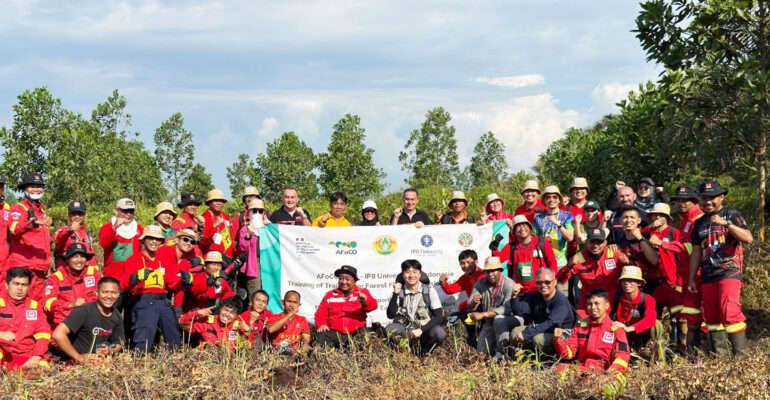IPB University Facilitates Peat Fire Extinguishing Training Directly in Ketapang, West Kalimantan

The Regional Fire Management Resource Center-Southeast Asia (RFMRC-SEA) team from the Faculty of Forestry and Environment (Fahutan) at IPB University conducted a peatland fire extinguishing training (karhutla) with hands-on practice in Ketapang, West Kalimantan (Kalbar), a region known for its vulnerability to peatland fires.
The training involved 19 participants from the Philippines, Malaysia, Timor-Leste, and Indonesia, who had previously completed a one-week training at IPB University under the guidance of three fire experts from France. The program encompassed fire suppression materials and incorporated training with fire simulators.
The operation area (Daops) IX/Manggala Agni (MA) Ketapang served as the home base for the training participants. Four fire extinguishing teams (15 firefighters) were deployed, along with the necessary equipment and supporting facilities.
IPB University’s expert team, consisting of Prof Bambang Hero Saharjo, Prof Lailan Syaufina, and Dr. Ati Dwi Nurhayati, presented on the causes and impacts of peatland fires. Meanwhile, strategies for extinguishing fires and the proper use of extinguishing equipment were demonstrated by the Daops IX/MA Ketapang team.
“We also conducted a dry simulation to help participants become familiar with the equipment used. This way, during actual fire extinguishing operations, they will become familiar with the tools and techniques. They’ll be well-prepared,” said Prof Bambang Hero.
The following day, fire extinguishing activities were carried out in an actual peatland area. The chosen site was located near a road, with sufficient access to water sources.
“We also prepared plots of land with specific sizes and types of fuel to facilitate participants in observing the fire behavior, spread rate, flame length, wind direction, and local weather conditions,” he explained.
To better understand the area to be extinguished, various measurements were taken before the firefighting operations began. These included the thickness of the fuel, the volume of fuel to be used, air temperature, relative humidity, and wind speed.
The fire was extinguished in the plots that had been deliberately set on fire. Surrounding areas were sprayed with water to prevent the fire from spreading further. “We also used thermal camera drones to capture how the fire occurred, its temperature, and how it spread,” said Prof Bambang.
Prof Bambang mentioned that such training will continue to be conducted annually for the next four years in different peatland areas across Indonesia. (IAAS/PRP)



